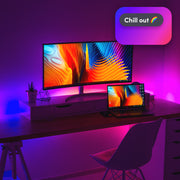

One of the best things about the LIFX Z, however, is that it works in zones - which essentially means that you can set the strip to show different colors at once. Those people would be better off buying a device that they can use over Wi-Fi and without a hub, like the LIFX Z. Our current favorite, the Philips Hue Lightstrip Plus, requires the use of a $40 hub, which isn't ideal for those who only want to use a light strip and not buy additional lights. There are a few things that make the LIFX Z light strip stand out - namely that it doesn't require the use of a hub and supports a range of smart home ecosystems. That said, once everything is set up, you may not have to use the app at all, especially if you use a smart home system like Apple HomeKit, Google Assistant, or Amazon Alexa.

It was sometimes slow to react to changes and skipped around a bit.

I found that the app was fine and easy to navigate, but a little buggy at times. It's also worth considering the design of the app. Once set up, the light strip supports a whopping 16 million colors, meaning that you can set it to any color you can imagine. I found that the light strip was pretty secure when attached with the adhesive, it never felt like it would come off even after a month later. On the back of each light strip segment, there's 3M double-sided tape so you can attach it to pretty much any surface. It's not quite as versatile as the Philips Hue Lightstrip Plus, which allows you to literally cut the light strip to the size you need, but it's nice that there is some customization. What that means is that you can use one strip or both at the same time depending on your space. In the box, you'll get a power supply and two strips of light, each a little more than three feet long. The LIFX Z looks more or less the same as any other light strip except for a few things that make the device a little more convenient.


 0 kommentar(er)
0 kommentar(er)
